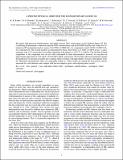| dc.contributor.author | Barry, Richard K. | |
| dc.contributor.author | Forveille, Thierry | |
| dc.contributor.author | Danchi, W. C. | |
| dc.contributor.author | Di Folco, E. | |
| dc.contributor.author | Queloz, D. | |
| dc.contributor.author | Spooner, H. R. | |
| dc.contributor.author | Torres, G. | |
| dc.contributor.author | Traub, W. A. | |
| dc.contributor.author | Delfosse, Xavier | |
| dc.contributor.author | Mayor, Michel | |
| dc.contributor.author | Perrier, C. | |
| dc.contributor.author | Udry, S. | |
| dc.contributor.author | Demory, Brice-Olivier | |
| dc.contributor.author | Segransan, D. | |
| dc.date.accessioned | 2015-02-25T21:17:49Z | |
| dc.date.available | 2015-02-25T21:17:49Z | |
| dc.date.issued | 2012-11 | |
| dc.date.submitted | 2012-08 | |
| dc.identifier.issn | 0004-637X | |
| dc.identifier.issn | 1538-4357 | |
| dc.identifier.uri | http://hdl.handle.net/1721.1/95635 | |
| dc.description.abstract | We report high-precision interferometric and radial velocity (RV) observations of the M-dwarf binary Gl 268. Combining measurements conducted using the IOTA interferometer and the ELODIE and Harvard Center for Astrophysics RV instruments leads to a mass of 0.22596 ± 0.00084 M [subscript ☉] for component A and 0.19230 ± 0.00071 M [subscript ☉] for component B. The system parallax as determined by these observations is 0.1560 ± 0.0030 arcsec—a measurement with 1.9% uncertainty in excellent agreement with Hipparcos (0.1572 ± 0.0033). The absolute H-band magnitudes of the component stars are not well constrained by these measurements; however, we can place an approximate upper limit of 7.95 and 8.1 for Gl 268A and B, respectively. We test these physical parameters against the predictions of theoretical models that combine stellar evolution with high fidelity, non-gray atmospheric models. Measured and predicted values are compatible within 2σ. These results are among the most precise masses measured for visual binaries and compete with the best adaptive optics and eclipsing binary results. | en_US |
| dc.description.sponsorship | United States. National Aeronautics and Space Administration | en_US |
| dc.description.sponsorship | Jet Propulsion Laboratory (U.S.) | en_US |
| dc.description.sponsorship | Harvard-Smithsonian Center for Astrophysics | en_US |
| dc.description.sponsorship | Université de Grenoble Observatory | en_US |
| dc.description.sponsorship | W. M. Keck Observatory | en_US |
| dc.language.iso | en_US | |
| dc.publisher | IOP Publishing | en_US |
| dc.relation.isversionof | http://dx.doi.org/10.1088/0004-637x/760/1/55 | en_US |
| dc.rights | Article is made available in accordance with the publisher's policy and may be subject to US copyright law. Please refer to the publisher's site for terms of use. | en_US |
| dc.source | American Astronomical Society | en_US |
| dc.title | A PRECISE PHYSICAL ORBIT FOR THE M-DWARF BINARY GLIESE 268 | en_US |
| dc.type | Article | en_US |
| dc.identifier.citation | Barry, R. K., B.-O. Demory, D. Ségransan, T. Forveille, W. C. Danchi, E. Di Folco, D. Queloz, et al. “A PRECISE PHYSICAL ORBIT FOR THE M-DWARF BINARY GLIESE 268.” The Astrophysical Journal 760, no. 1 (November 2, 2012): 55. © 2012 The American Astronomical Society | en_US |
| dc.contributor.department | Massachusetts Institute of Technology. Department of Earth, Atmospheric, and Planetary Sciences | en_US |
| dc.contributor.mitauthor | Demory, Brice-Olivier | en_US |
| dc.contributor.mitauthor | Segransan, D. | en_US |
| dc.contributor.mitauthor | Di Folco, E. | en_US |
| dc.contributor.mitauthor | Udry, S. | en_US |
| dc.contributor.mitauthor | Queloz, D. | en_US |
| dc.relation.journal | Astrophysical Journal | en_US |
| dc.eprint.version | Final published version | en_US |
| dc.type.uri | http://purl.org/eprint/type/JournalArticle | en_US |
| eprint.status | http://purl.org/eprint/status/PeerReviewed | en_US |
| dspace.orderedauthors | Barry, R. K.; Demory, B.-O.; Ségransan, D.; Forveille, T.; Danchi, W. C.; Di Folco, E.; Queloz, D.; Spooner, H. R.; Torres, G.; Traub, W. A.; Delfosse, X.; Mayor, M.; Perrier, C.; Udry, S. | en_US |
| mit.license | PUBLISHER_POLICY | en_US |
| mit.metadata.status | Complete | |
